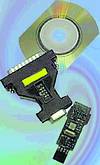

The SX-ISP from Kanda has been designed for maximum convenience and flexibility. Since in-system programming means the device is programmed after soldering, allowing 'one build, later customisation', separate test code vectors can be programmed first for function testing before programming with finished code. This makes field upgrades easy, and it makes sense to use ISP.
Since one's workbench and briefcase space is always at a premium, users will be pleased to know that the 'Programming Key' powers itself from one's target system so no additional power supply is required. The programming key is built on the tried and tested 4-pin connector design for compatibility with existing designs. The key also incorporates a superior connector designed to reduce electrical noise and improve system reliability.
Kanda multiconnector
One of the decisions faced when choosing a programming system is what PC connection to use. A development PC may already have a printer, modem, logic analyser or in-circuit-emulator; a field engineer's laptop will typically have a single serial port (normally used by the mouse) and a Production PC will have another programming system or test gear.
To allow the Kanda product to be used in all of these environments with complete flexibility Kanda designed an industry-leading ISP system which features a PC printer port and serial port multiconnector. This allows one to attach the ISP system to any free printer or serial port, whilst maintaining a compact design small enough to keep in a briefcase.
The programmer includes a hex file editor, which allows one to edit and view a file prior to programming the device. This is useful for making small changes to one's program code outside of the development environment. Typical uses are: including serial number information; calibration settings; or applying manual patches.
As well as being ideally suited for the development environment the ISP has some added extras for use on a production line. The auto verify/program facility allows users to load your files and fuse options, and then perform complete program cycles with a single click. Programming times per location can also be customised to allow one to shorten the time spent on each target.
The user interface has been carefully designed to provide 'easy operation', coupled with advanced features for the power user. The standard erase, device empty check, read, program and verify functions are available via single mouse click or keyboard shortcut.
For the advanced user, FUSE & FUSEX configuration override options are provided as well as programming time customisation to optimise programming time whilst maintaining programming reliability.
| Tel: | +27 11 887 7879 |
| Email: | [email protected] , [email protected] |
| www: | |
| Articles: | More information and articles about Sivan Electronic Supplies |

© Technews Publishing (Pty) Ltd | All Rights Reserved